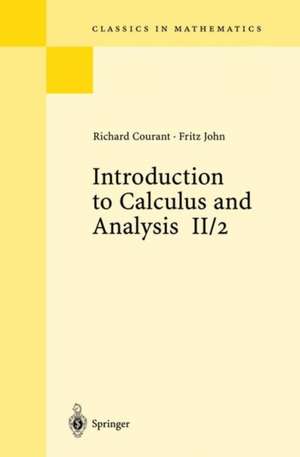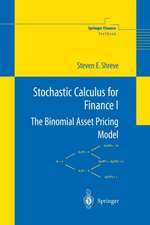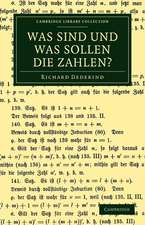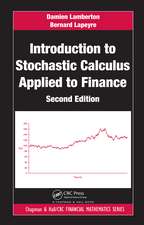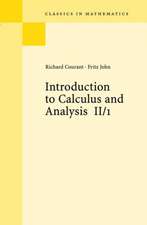Introduction to Calculus and Analysis II/2: Chapters 5 - 8: Classics in Mathematics
Autor Richard Courant, Fritz Johnen Limba Engleză Paperback – 14 dec 1999
Newsletter on Computational and Applied Mathematics, 1991
"...one of the best textbooks introducing several generations of mathematicians to higher mathematics. ... This excellent book is highly recommended both to instructors and students.
Acta Scientiarum Mathematicarum, 1991
Din seria Classics in Mathematics
-
 Preț: 404.18 lei
Preț: 404.18 lei -
 Preț: 428.05 lei
Preț: 428.05 lei -
 Preț: 400.47 lei
Preț: 400.47 lei -
 Preț: 404.34 lei
Preț: 404.34 lei -
 Preț: 402.27 lei
Preț: 402.27 lei -
 Preț: 422.11 lei
Preț: 422.11 lei -
 Preț: 438.87 lei
Preț: 438.87 lei -
 Preț: 425.80 lei
Preț: 425.80 lei -
 Preț: 429.61 lei
Preț: 429.61 lei -
 Preț: 421.72 lei
Preț: 421.72 lei -
 Preț: 425.80 lei
Preț: 425.80 lei -
 Preț: 422.90 lei
Preț: 422.90 lei -
 Preț: 427.49 lei
Preț: 427.49 lei -
 Preț: 421.17 lei
Preț: 421.17 lei -
 Preț: 415.39 lei
Preț: 415.39 lei -
 Preț: 485.07 lei
Preț: 485.07 lei -
 Preț: 437.72 lei
Preț: 437.72 lei -
 Preț: 444.47 lei
Preț: 444.47 lei -
 Preț: 440.39 lei
Preț: 440.39 lei -
 Preț: 447.73 lei
Preț: 447.73 lei -
 Preț: 438.10 lei
Preț: 438.10 lei -
 Preț: 509.50 lei
Preț: 509.50 lei -
 Preț: 418.83 lei
Preț: 418.83 lei -
 Preț: 436.74 lei
Preț: 436.74 lei -
 Preț: 446.37 lei
Preț: 446.37 lei -
 Preț: 430.59 lei
Preț: 430.59 lei -
 Preț: 421.93 lei
Preț: 421.93 lei -
 Preț: 429.06 lei
Preț: 429.06 lei -
 Preț: 431.56 lei
Preț: 431.56 lei -
 Preț: 457.36 lei
Preț: 457.36 lei -
 Preț: 429.99 lei
Preț: 429.99 lei -
 Preț: 504.66 lei
Preț: 504.66 lei -
 Preț: 433.31 lei
Preț: 433.31 lei -
 Preț: 418.07 lei
Preț: 418.07 lei -
 Preț: 428.07 lei
Preț: 428.07 lei -
 Preț: 427.33 lei
Preț: 427.33 lei -
 Preț: 437.50 lei
Preț: 437.50 lei -
 Preț: 425.80 lei
Preț: 425.80 lei -
 Preț: 438.26 lei
Preț: 438.26 lei -
 Preț: 408.61 lei
Preț: 408.61 lei -
 Preț: 432.51 lei
Preț: 432.51 lei -
 Preț: 429.61 lei
Preț: 429.61 lei -
 Preț: 435.20 lei
Preț: 435.20 lei -
 Preț: 428.68 lei
Preț: 428.68 lei -
 Preț: 437.12 lei
Preț: 437.12 lei -
 Preț: 438.69 lei
Preț: 438.69 lei
Preț: 431.56 lei
Nou
Puncte Express: 647
Preț estimativ în valută:
82.58€ • 86.45$ • 68.33£
82.58€ • 86.45$ • 68.33£
Carte tipărită la comandă
Livrare economică 05-19 aprilie
Preluare comenzi: 021 569.72.76
Specificații
ISBN-13: 9783540665700
ISBN-10: 3540665706
Pagini: 444
Ilustrații: XXV, 412 p. 68 illus.
Dimensiuni: 155 x 235 x 27 mm
Greutate: 0.66 kg
Ediția:Reprint of the 1st ed. New York 1989.
Editura: Springer Berlin, Heidelberg
Colecția Springer
Seria Classics in Mathematics
Locul publicării:Berlin, Heidelberg, Germany
ISBN-10: 3540665706
Pagini: 444
Ilustrații: XXV, 412 p. 68 illus.
Dimensiuni: 155 x 235 x 27 mm
Greutate: 0.66 kg
Ediția:Reprint of the 1st ed. New York 1989.
Editura: Springer Berlin, Heidelberg
Colecția Springer
Seria Classics in Mathematics
Locul publicării:Berlin, Heidelberg, Germany
Public țintă
ResearchCuprins
5 Relations Between Surface and Volume Integrals.- 6 Differential Equations.- 7 Calculus of VariationsMultipliers.- 8 Functions of a Complex Variable.- List of Biographical Dates.- Index.
Recenzii
From the reviews: "These books (Introduction to Calculus and Analysis Vol. I/II) are very well written. The mathematics are rigorous but the many examples that are given and the applications that are treated make the books extremely readable and the arguments easy to understand. These books are ideally suited for an undergraduate calculus course. Each chapter is followed by a number of interesting exercises. More difficult parts are marked with an asterisk. There are many illuminating figures...Of interest to students, mathematicians, scientists and engineers. Even more than that." Newsletter on Computational and Applied Mathematics, 1991 "...one of the best textbooks introducing several generations of mathematicians to higher mathematics. ... This excellent book is highly recommended both to instructors and students. Acta Scientiarum Mathematicarum, 1991
Notă biografică
Biography of Richard Courant
Richard Courant was born in 1888 in a small town of what is now Poland, and died in New Rochelle, N.Y. in 1972. He received his doctorate from the legendary David Hilbert in Göttingen, where later he founded and directed its famed mathematics Institute, a Mecca for mathematicians in the twenties. In 1933 the Nazi government dismissed Courant for being Jewish, and he emigrated to the United States. He found, in New York, what he called "a reservoir of talent" to be tapped. He built, at New York University, a new mathematical Sciences Institute that shares the philosophy of its illustrious predecessor and rivals it in worldwide influence.
For Courant mathematics was an adventure, with applications forming a vital part. This spirit is reflected in his books, in particular in his influential calculus text, revised in collaboration with his brilliant younger colleague, Fritz John.
(P.D. Lax)
Biography of Fritz John
Fritz John was born on June 14, 1910, in Berlin. After his school years in Danzig (now Gdansk, Poland), he studied in Göttingen and received his doctorate in 1933, just when the Nazi regime came to power. As he was half-Jewish and his bride Aryan, he had to flee Germany in 1934. After a year in Cambridge, UK, he accepted a position at the University of Kentucky, and in 1946 joined Courant, Friedrichs and Stoker in building up New York University the institute that later became the Courant Institute of Mathematical Sciences. He remained there until his death in New Rochelle on February 10, 1994.
John's research and the books he wrote had a strong impact on the development of many fields of mathematics, foremost in partial differential equations. He also worked on Radon transforms, illposed problems, convex geometry, numerical analysis, elasticity theory. In connection with his work in latter field, he and Nirenberg introduced the space of the BMO-functions (bounded mean oscillations). Fritz John's work exemplifies the unity of mathematics as well as its elegance and its beauty.
(J. Moser)
Richard Courant was born in 1888 in a small town of what is now Poland, and died in New Rochelle, N.Y. in 1972. He received his doctorate from the legendary David Hilbert in Göttingen, where later he founded and directed its famed mathematics Institute, a Mecca for mathematicians in the twenties. In 1933 the Nazi government dismissed Courant for being Jewish, and he emigrated to the United States. He found, in New York, what he called "a reservoir of talent" to be tapped. He built, at New York University, a new mathematical Sciences Institute that shares the philosophy of its illustrious predecessor and rivals it in worldwide influence.
For Courant mathematics was an adventure, with applications forming a vital part. This spirit is reflected in his books, in particular in his influential calculus text, revised in collaboration with his brilliant younger colleague, Fritz John.
(P.D. Lax)
Biography of Fritz John
Fritz John was born on June 14, 1910, in Berlin. After his school years in Danzig (now Gdansk, Poland), he studied in Göttingen and received his doctorate in 1933, just when the Nazi regime came to power. As he was half-Jewish and his bride Aryan, he had to flee Germany in 1934. After a year in Cambridge, UK, he accepted a position at the University of Kentucky, and in 1946 joined Courant, Friedrichs and Stoker in building up New York University the institute that later became the Courant Institute of Mathematical Sciences. He remained there until his death in New Rochelle on February 10, 1994.
John's research and the books he wrote had a strong impact on the development of many fields of mathematics, foremost in partial differential equations. He also worked on Radon transforms, illposed problems, convex geometry, numerical analysis, elasticity theory. In connection with his work in latter field, he and Nirenberg introduced the space of the BMO-functions (bounded mean oscillations). Fritz John's work exemplifies the unity of mathematics as well as its elegance and its beauty.
(J. Moser)
Textul de pe ultima copertă
Richard Courant was born in 1888 in a small town of what is now Poland, and died in New Rochelle, N.Y. in 1972. He received his doctorate from the legendary David Hilbert in Göttingen, where later he founded and directed its famed mathematics Institute, a Mecca for mathematicians in the twenties. In 1933 the Nazi government dismissed Courant for being Jewish, and he emigrated to the United States. He found, in New York, what he called "a reservoir of talent" to be tapped. He built, at New York University, a new mathematical Sciences Institute that shares the philosophy of its illustrious predecessor and rivals it in worldwide influence.
For Courant mathematics was an adventure, with applications forming a vital part. This spirit is reflected in his books, in particular in his influential calculus text, revised in collaboration with his brilliant younger colleague, Fritz John. (P.D. Lax)
Fritz John was born on June 14, 1910, in Berlin. After his school years in Danzig (now Gdansk, Poland), he studied in Göttingen and received his doctorate in 1933, just when the Nazi regime came to power. As he was half-Jewish and his bride Aryan, he had to flee Germany in 1934. After a year in Cambridge, UK, he accepted a position at the University of Kentucky, and in 1946 joined Courant, Friedrichs and Stoker in building up New York University the institute that later became the Courant Institute of Mathematical Sciences. He remained there until his death in New Rochelle on February 10, 1994.
John's research and the books he wrote had a strong impact on the development of many fields of mathematics, foremost in partial differential equations. He also worked on Radon transforms, illposed problems, convex geometry, numerical analysis, elasticity theory. In connection with his work in latter field, he and Nirenberg introduced the space of the BMO-functions (bounded mean oscillations). Fritz John's work exemplifies the unity of mathematics as well as its elegance and itsbeauty. (J. Moser)
For Courant mathematics was an adventure, with applications forming a vital part. This spirit is reflected in his books, in particular in his influential calculus text, revised in collaboration with his brilliant younger colleague, Fritz John. (P.D. Lax)
Fritz John was born on June 14, 1910, in Berlin. After his school years in Danzig (now Gdansk, Poland), he studied in Göttingen and received his doctorate in 1933, just when the Nazi regime came to power. As he was half-Jewish and his bride Aryan, he had to flee Germany in 1934. After a year in Cambridge, UK, he accepted a position at the University of Kentucky, and in 1946 joined Courant, Friedrichs and Stoker in building up New York University the institute that later became the Courant Institute of Mathematical Sciences. He remained there until his death in New Rochelle on February 10, 1994.
John's research and the books he wrote had a strong impact on the development of many fields of mathematics, foremost in partial differential equations. He also worked on Radon transforms, illposed problems, convex geometry, numerical analysis, elasticity theory. In connection with his work in latter field, he and Nirenberg introduced the space of the BMO-functions (bounded mean oscillations). Fritz John's work exemplifies the unity of mathematics as well as its elegance and itsbeauty. (J. Moser)
Caracteristici
Written by an expert With many examples and applications Easy to understand
